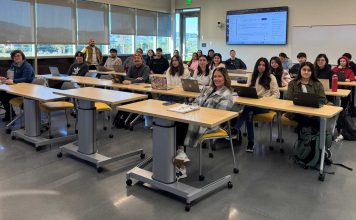A new $1.37 million state grant for downpayment assistance could
provide a shot in the arm to a beleaguered housing project east of
downtown
– and a glimmer of hope for a resurgence in the area.
A new $1.37 million state grant for downpayment assistance could provide a shot in the arm to a beleaguered housing project east of downtown – and a glimmer of hope for a resurgence in the area.
The city announced Tuesday that Gilroy received a Building Equity and Growth in Neighborhoods Program grant that will provide down payment assistance for new townhouses in the sputtering 210-unit South County Cannery development.
“It will get more people to live, eat, and shop downtown,” said Suzanne Tobin, the housing specialist for the City of Gilroy who applied for the grant. “Having the project moving along is a boost for city.”
The money will help nonprofit developer South County Housing finish 32 homes in the second phase of its Cannery project, which stands on the site of the former Filice and Perrelli Cannery site bordered by Forest and Lewis streets, and bring new life to an area that had been hailed as a cornerstone in a hoped-for downtown revival.
Those hopes were dashed when the recession hit in late 2007 and the housing market collapsed.
The grant will provide downpayment assistance for up to 20 percent of the home value for each of the remaining 24 homes, with prices expected to range from $270,000 to $305,000, according to city staff. The average loan amount will be $57,200, city staff said.
“This new grant is a significant step forward for Gilroy and its efforts to ensure an affordable housing supply,” City Administrator Tom Haglund said.
South County Housing CEO Dennis Lalor hopes additional construction on the project’s second phase will start within a year. He said he wants to make sure prospective buyers are lined up before that happens.
“Banks are not interested in lending if they don’t have a clear idea when they will get paid back,” he said.
The sale of the eighth home in Alexander Place will allow South County to renew a $1.5-million state construction loan it has combined with a bank loan, providing funding that will help pay for Alexander Place’s remaining 24 units.
In turn, new construction will boost the economy, Lalor said. Using commonly used ratios from the National Association of Homebuilders, he estimated that building the remaining homes in the second phase would generate 81 jobs and contribute $5.2 million to the local economy.
The Cannery project was envisioned as a key component in revitalizing downtown before construction started in 2007. City Council candidates in 2003 compared it to Japantown in San Jose because of its mixed-use qualities.
News of the new grant comes on the heels of last month’s announcement that the former Garlic Festival building sold for $4 million and will be ready for new occupants next month. That building, now known as Allium, will start taking tenants at Fourth and Monterey streets in August.
Downtown hubs in other cities have experienced success by using a similar “more is better” formula, downtown developer Gary Walton said.
Having more people downtown means they will more likely patronize local businesses, which raises sales, Walton explained. In turn, that enables rents to go up and allows property owners to improve buildings and attract more business.
Walton said higher density projects are the wave of the future, as experts such as “walkable urbanism” proponent Christopher B. Leinberger has claimed that less than 20 percent of couples will have children in the future.
Young adults these days grew up watching shows such as “Friends” and “Seinfeld,” where people lived in lofts in urban settings, and they find those types of dwellings to be desirable, Walton said.
No buyers, however, desired Cannery Project homes when the bottom fell out.
Representatives from developer South County Housing requested – and ultimately received the promise of – a $675,00 loan from the City Council to bail out the project only to turn around later that year and deem it unnecessary after home sales started picking up.
These days, the Forest Park first phase of the project, which consists of 39 single-family homes, has all been sold. Five of the first eight homes in the 32-unit Alexander Place second phase are sold and two are under contract. Prices have been around $270,000 to $290,000.
Construction on the 139-unit third phase, which will consist of townhouses and condominiums along with 45,000 square feet of commercial space and a parking structure, will not begin until Alexander Place is complete.
“I would say (demand) goes up and down,” Lalor said of the project. “It’s still a lot slower than I would like to see.”
Like the Cannery project, the three-story Allium project is experiencing a resurgence after falling on hard times. Stromiga Real Estate Development, which has offices in Saratoga and Canada, bought the building last month after it had become bank-owned when the Gilroy Garlic Festival Association could no longer make payments.
The Garlic Festival Association built the mixed-use edifice through a partnership with a group of investors led by builder Randy Moen of Tanglewood Construction. The association inhabited part of the bottom floor of the building for about a year, and much of the lower part of the building will continue to house shops and offices while apartments will occupy the remainder of the building.
Allium is set to take new residents starting Aug. 7, according to Scott Safadi, president of Cal Bay Property Management, which is overseeing leasing of the property. Apartment rates will range from $1,250 per month for a one-bedroom, 700-square-foot apartment to about $1,900 for a two-bedroom apartment with nearly 2,040 square feet.
Although the dwellings inside initially were slated to be sold, Safadi said it will be awhile before they serve their original purpose, as Freddie Mac and Fannie Mae will not finance condominiums these days.
Still, Walton has said the popular Santana Row neighborhood in San Jose similarly started with rentals before it obtained the vitality that made people want to buy there.
Energy generates in a downtown setting when people can easily walk from their homes to shops and restaurants, Walton said.
A website called Walk Score, which rates neighborhoods by how easy it is to walk to destination spots such as stores, bars and libraries, rates the Cannery project area 85 out of 100, or “very walkable.”
Still, downtown access for part of the Forest Park portion of the Cannery project is cut off these days, as a construction fence and the railroad tracks separate it from the rest of downtown. Eventually, a foot bridge will provide downtown access once phase III is done. A bicycle trail and walking paths are also in the plans.
Despite current struggles, Mayor Al Pinheiro still believes the development will play a major role in the transformation of downtown.
“(South County Housing) had a great plan, and I still truly believe that someday it’s going to happen,” Pinheiro said.












